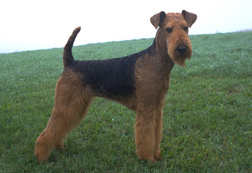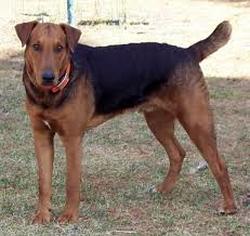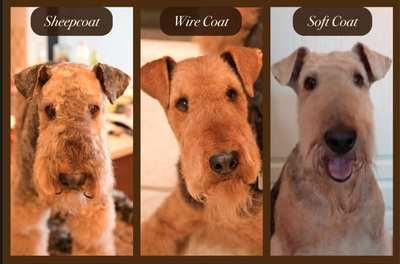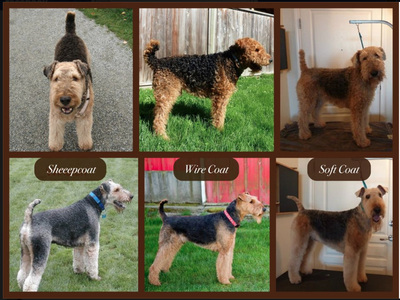Airedale Breed Information

Airedale Terriers make wonderful companions. But, like all purebred dogs, have been genetically engineered through breeding to possess particular characteristics that make them a great choice for some people but a difficult experience for others. If you are not familiar with these kinds of dogs, but think you might want to bring one into your household, please take the time to learn about Airedales. The volunteers of ATRVA have many collective years of experience and are happy to help you with this important decision.
Physical Characteristics
Airedale terrier AKC photoThe American Kennel Club sets the standard for dogs intended for the show ring, but the appearance of pet Airedales varies considerably around this norm: standing between 20” and 28” at the shoulder and weighing between 40 and 100 lbs.—or more. All have the distinctive tan or russet brown head, neck and legs with a black (sometimes grizzled) ‘cape’ looping around their upper chest and covering their backs to the tail. Many have hard, wiry coats, but some have soft, curly coats. Coloration, size, ear shape and position, and an overall square and sturdy build distinguish the Airedale from other terriers and terrier mixes.
A Note on Allergies: It is commonly thought that Airedales are hypoallergenic because they don’t shed. In fact, they do shed, but it is managed with regular grooming. Although some people with dog-related allergy are able to live with Airedales, others are not. If you, or someone in your family, are allergic to dogs and you are considering adopting an Airedale for this reason, please let us know.
Habit and Temperament
Ask any Airedale Terrier owner about their dog and you will be laughingly treated to stories of mischief and mayhem. Airedales are noted for their sense of humor, and are often capable of putting demands on ours! Originally bred as an all-purpose farm dog and hunting companion, they are affectionate, playful (even into advanced years), tough, smart, and versatile, but their ancestry can lead them into trouble.
Energy: In comparison to retrieving and herding breeds, terriers are less biddable: more independent, harder to train, and less reliably obedient. Human patience can be taxed trying to manage an Airedale, particularly a puppy or adolescent. If these dogs are not given adequate daily exercise, their abundant energy may find a destructive outlet: chasing, chewing, barking, biting, and running off.
Prey drive: Selected to kill barnyard rodents, Airedales possess a strong prey drive—running after the neighbor’s cat as readily as that pesky garden-invading woodchuck. They can live peacefully with other household pets, including guinea pigs, rabbits, and gerbils, but be cautious when introducing an Airedale into a house with a smaller animal. If it runs, the Airedale may well decide to chase.
Tenacity, stubbornness, and stoicism: These admirable attributes make Airedale Terriers effective hunters of rats and weasels: digging vermin out of burrows, grabbing hold with strong jaws, and enduring savage bites and scratches without letting go. However, in today’s domestic environments, that can translate into deep holes in the middle of your flowerbeds and shredded trash on the kitchen floor. And, their high pain threshold can make the timely recognition of internal injury or illness difficult.
Care Requirements
Veterinarian: Rescue recommends making an appointment with your vet within the first month after adoption and scheduling annual check-ups thereafter. Staying current with vaccinations is vital.
Licensing: Dogs in the United States and Canada are required to be licensed by the local municipality. Proof of current rabies vaccination must be submitted. Fees vary by jurisdiction.
Regular exercise: Exercise is crucial to the well-being of energetic Airedale Terriers. They are strong, active dogs and should be walked daily. If you will be away from the house for more than four hours, arrange for someone to walk your dog.
Unless you are absolutely certain that you have total verbal control over your dog, an Airedale should be on a leash or within an enclosed area at all times. This is why Rescue wants adopters to have a fenced yard. A strong prey drive and a tendency to wander can get Airedale Terriers into danger.
Obedience training: Even if you and your adopted Airedale have separately been in training classes before the adoption, taking a basic obedience course together develops a common language of communication and strengthens the new dog-human bond. In addition, the instructor can support you both while you adjust to the new relationship. Because Airedales are smart, stubborn, and independent, we recommend a positive, gentle, and consistent training method as most effective.
Grooming: A well-groomed Airedale is very handsome but requires regular, scheduled maintenance.
Daily to weekly, coats need to be brushed to discourage matting.
Weekly, ears and teeth should be checked. Ask your vet how to spot signs of damage or infection.
Every month or so, depending on activity and walking surfaces, toenails need to be trimmed.
Every six to twelve weeks, depending on seasonal weather conditions, a healthy Airedale needs to be groomed: either “stripped” or clipped. Contrary to common belief, Airedales do shed, but proper grooming minimizes the amount. (See A Note of Allergies above.)
Stripping is a specialized and very expensive process, usually reserved for show dogs and always best left to an expert. Click HERE to see how it is done.
Clipping can be performed by any skilled groomer familiar with the breed but can cost between $50 and $70 per session. Many owners save this expense by investing in good quality electric clippers and learning to do it themselves.
Bathing is usually done at the same time as clipping. Because Airedale Terriers tend to develop itchy skin, they should not be bathed more often than necessary to control dirt and odor.
Airedale Coat Types: Soft Coat, Wire Coat, Sheep Coat and Redline (slick coat)
Airedale Coats: Soft Coat, Wire Coat and Sheepcoat. Purebred Airedale can have any coat, but the sheepcoat is the least common.

Redline or Slick Coat Airedales are "NOT" a cross breed. They can and have, and still will occur in many Airedale lines, simply put it is basically a genetic anomaly for a short dense hard coat. They seem to shed more. And they have drive and very good hunting or having a job. These are uncommon, but over the last 10 years we have placed 2 Redlines and 150-200 Airedales.


